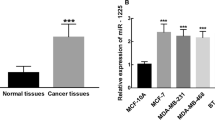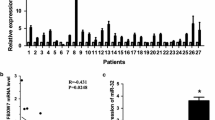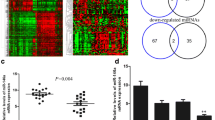Abstract
Background
MicroRNAs (miRNAs) are well known to play crucial role in various types of cancers, including breast cancer (BC).
Methods
The present study aimed to investigate the expression, clinical value, and functional role of miR-302b in BC. The expression level of miR-302b was determined by quantitative real-time polymerase chain reaction (qRT-PCR). The clinical value of miR-302b in BC prognosis was calculated via Kaplan–Meier survival analysis and Cox regression analysis. Cell experiments were applied to investigate the functional role of miR-302b in BC.
Results
miR-302b was significantly downregulated in BC tissues and cell lines compared to the corresponding controls (all P < 0.01). Notably, the expression of miR-302b was significantly associated with lymph node metastasis and TNM stage (all P < 0.05). Patients with lower miR-302b expression had shorter survival time than those with higher miR-302b expression (log-rank P = 0.002). Furthermore, miR-302b expression and TNM stage were proven to be independent prognostic factors for BC. Overexpression of miR-302b inhibited BC cell proliferation, migration, and invasion in BT549 and MCF-7 cell lines, while silence of miR-302b exhibited an opposite effects on BC cells (all P < 0.05). RUNX2 was determined to be the target gene of miR-302b.
Conclusions
The present study suggests that miR-302b functions as a tumor suppressor in BC and inhibits the tumor progression of BC via targeting RUNX2. Downregulation of miR-302b might be a significant prognostic factor for poor survival in BC patients.




Similar content being viewed by others
References
Torre LA, Islami F, Siegel RL, Ward EM, Jemal A. Global cancer in women: burden and trends. Cancer Epidemiol Biomark Prev. 2017;26:444–57.
Siegel R, Naishadham D, Jemal A. Cancer statistics, 2013. CA Cancer J Clin. 2013;63:11–30.
Fan L, Strasser-Weippl K, Li JJ, St Louis J, Finkelstein DM, Yu KD, et al. Breast cancer in China. Lancet Oncol. 2014;15:e279–89.
Schmielau J, Rick O, Reuss-Borst M, Kalusche-Bontemps EM, Steimann M. Rehabilitation of cancer survivors with long-term toxicities. Oncol Res Treat. 2017;40:764–71.
Qin Q, Tan Q, Li J, Yang W, Lian B, Mo Q, et al. Elevated expression of POLD1 is associated with poor prognosis in breast cancer. Oncol Lett. 2018;16:5591–8.
Ryu TY, Kim K, Kim SK, Oh JH, Min JK, Jung CR, et al. SETDB1 regulates SMAD7 expression for breast cancer metastasis. BMB Rep. 2019;52(2):139–44.
Iranifar E, Seresht BM, Momeni F, Fadaei E, Mehr MH, Ebrahimi Z, et al. Exosomes and microRNAs: new potential therapeutic candidates in Alzheimer disease therapy. J Cell Physiol. 2019;234:2296–305.
Noruzi S, Azizian M, Mohammadi R, Hosseini SA, Rashidi B, Mohamadi Y, et al. Micro-RNAs as critical regulators of matrix metalloproteinases in cancer. J Cell Biochem. 2018;119:8694–712.
Rupaimoole R, Slack FJ. MicroRNA therapeutics: towards a new era for the management of cancer and other diseases. Nat Rev Drug Discov. 2017;16:203–22.
Yu W, Liang X, Li X, Zhang Y, Sun Z, Liu Y, et al. MicroRNA-195: a review of its role in cancers. Onco Targets Ther. 2018;11:7109–23.
Lou W, Liu J, Ding B, Xu L, Fan W. Identification of chemoresistance-associated miRNAs in breast cancer. Cancer Manag Res. 2018;10:4747–57.
Tian Y, Fu X, Li Q, Wang Y, Fan D, Zhou Q, et al. MicroRNA181 serves an oncogenic role in breast cancer via the inhibition of SPRY4. Mol Med Rep. 2018;18:5603–13.
Zhu X, Rao X, Yao W, Zou X. Downregulation of MiR-196b-5p impedes cell proliferation and metastasis in breast cancer through regulating COL1A1. Am J Transl Res. 2018;10:3122–32.
Wu A, Chen Y, Liu Y, Lai Y, Liu D. miR-199b-5p inhibits triple negative breast cancer cell proliferation, migration and invasion by targeting DDR1. Oncol Lett. 2018;16:4889–96.
Cataldo A, Cheung DG, Balsari A, Tagliabue E, Coppola V, Iorio MV, et al. miR-302b enhances breast cancer cell sensitivity to cisplatin by regulating E2F1 and the cellular DNA damage response. Oncotarget. 2016;7:786–97.
Chen D, Yang H. Integrated analysis of differentially expressed genes in breast cancer pathogenesis. Oncol Lett. 2015;9:2560–6.
Coates AS, Winer EP, Goldhirsch A, Gelber RD, Gnant M, Piccart-Gebhart M, et al. Tailoring therapies–improving the management of early breast cancer: St Gallen International Expert Consensus on the Primary Therapy of Early Breast Cancer 2015. Ann Oncol. 2015;26:1533–46.
Sutter SA, Slinker A, Balumuka DD, Mitchell KB. Surgical management of breast cancer in Africa: a continent-wide review of intervention practices, barriers to care, and adjuvant therapy. J Glob Oncol. 2017;3:162–8.
Hindie E, Groheux D. Regional nodal irradiation in early-stage breast cancer. N Engl J Med. 2015;373:1877–8.
Khalighfard S, Alizadeh AM, Irani S, Omranipour R. Plasma miR-21, miR-155, miR-10b, and Let-7a as the potential biomarkers for the monitoring of breast cancer patients. Sci Rep. 2018;8:17981.
Liu X, Zhang L, Tong Y, Yu M, Meng W, Dong D, et al. MicroRNA-22 inhibits proliferation, invasion and metastasis of breast cancer cells through targeting truncated neurokinin-1 receptor and ERalpha. Life Sci. 2019;217:57–69.
Zhao J, Jiang GQ. MiR-4282 inhibits proliferation, invasion and metastasis of human breast cancer by targeting Myc. Eur Rev Med Pharmacol Sci. 2018;22:8763–71.
Cai KT, Liu AG, Wang ZF, Jiang HW, Zeng JJ, He RQ, et al. Expression and potential molecular mechanisms of miR2045p in breast cancer, based on bioinformatics and a metaanalysis of 2,306 cases. Mol Med Rep. 2019;19(2):1168–84.
Lindholm E, Leivonen SK, Undlien E, Nebdal D, Git A, Caldas C, et al. miR-342-5p as a potential regulator of HER2 breast cancer cell growth. Microrna. 2019;8(2):155–65.
Huang J, He Y, McLeod HL, Xie Y, Xiao D, Hu H, et al. miR-302b inhibits tumorigenesis by targeting EphA2 via Wnt/beta-catenin/EMT signaling cascade in gastric cancer. BMC Cancer. 2017;17:886.
Li Z, Zhou L, Lin C, Pan X, Xie J, Zhao L, et al. MiR-302b regulates cell functions and acts as a potential biomarker to predict recurrence in bladder cancer. Life Sci. 2018;209:15–23.
Wang L, Yao J, Sun H, Sun R, Chang S, Yang Y, et al. miR-302b suppresses cell invasion and metastasis by directly targeting AKT2 in human hepatocellular carcinoma cells. Tumour Biol. 2016;37:847–55.
Ge T, Yin M, Yang M, Liu T, Lou G. MicroRNA-302b suppresses human epithelial ovarian cancer cell growth by targeting RUNX1. Cell Physiol Biochem. 2014;34:2209–20.
Zhang M, Yang Q, Zhang L, Zhou S, Ye W, Yao Q, et al. miR-302b is a potential molecular marker of esophageal squamous cell carcinoma and functions as a tumor suppressor by targeting ErbB4. J Exp Clin Cancer Res. 2014;33:10.
Zuo Z, Ye F, Liu Z, Huang J, Gong Y. MicroRNA-153 inhibits cell proliferation, migration, invasion and epithelial-mesenchymal transition in breast cancer via direct targeting of RUNX2. Exp Ther Med. 2019;17:4693–702.
Chen H, Ghori-Javed FY, Rashid H, Adhami MD, Serra R, Gutierrez SE, et al. Runx2 regulates endochondral ossification through control of chondrocyte proliferation and differentiation. J Bone Miner Res. 2014;29:2653–65.
Chang CH, Fan TC, Yu JC, Liao GS, Lin YC, Shih AC, et al. The prognostic significance of RUNX2 and miR-10a/10b and their inter-relationship in breast cancer. J Transl Med. 2014;12:257.
Tandon M, Chen Z, Pratap J. Runx2 activates PI3 K/Akt signaling via mTORC2 regulation in invasive breast cancer cells. Breast Cancer Res. 2014;16:R16.
Pratap J, Wixted JJ, Gaur T, Zaidi SK, Dobson J, Gokul KD, et al. Runx2 transcriptional activation of Indian Hedgehog and a downstream bone metastatic pathway in breast cancer cells. Cancer Res. 2008;68:7795–802.
Author information
Authors and Affiliations
Corresponding author
Ethics declarations
Conflict of interest
The authors have declared no conflict of interest.
Additional information
Publisher's Note
Springer Nature remains neutral with regard to jurisdictional claims in published maps and institutional affiliations.
About this article
Cite this article
Ma, J., Zhou, Z. Downregulation of miR-302b is associated with poor prognosis and tumor progression of breast cancer. Breast Cancer 27, 291–298 (2020). https://doi.org/10.1007/s12282-019-01022-w
Received:
Accepted:
Published:
Issue Date:
DOI: https://doi.org/10.1007/s12282-019-01022-w




